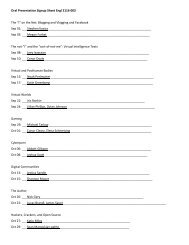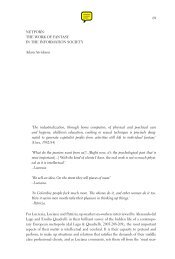Nakamura, Digitizing Race, Introduction, chapter 5, Epilogue
Nakamura, Digitizing Race, Introduction, chapter 5, Epilogue
Nakamura, Digitizing Race, Introduction, chapter 5, Epilogue
Create successful ePaper yourself
Turn your PDF publications into a flip-book with our unique Google optimized e-Paper software.
214 Notes to Chapter 2<br />
17. A QuickTime file of the eBay “Clocks” advertisement can be found at “Duncan’s<br />
TV Ad Land,” http://www.duncans.tv/2005/ebay-clocks, along with a commentary<br />
by Duncan McLeod.<br />
18. Probot Productions, the creators of this Alien series, has continued to make<br />
films using this method, and I thank them for sharing their work with me so generously.<br />
19. Filiciak, “Hyperidentities,” 91.<br />
20. Manovich, The Language of New Media, 128.<br />
21. See Barthes, Music/Image/Text; and Foucault, “What Is an Author?”<br />
22. Manovich, The Language of New Media, 30.<br />
23. For examples of this scholarship, see Bolter, Grusin, and NetLibrary Inc.,<br />
Remediation; and Darley, Visual Digital Culture.<br />
24. Persson, “Cinema and Computers.”<br />
25. Ibid., 42.<br />
26. Rebecca Solnit notes the historical connections forged between two of California’s<br />
biggest industries—computers and motion pictures—by Muybridge’s motion<br />
studies, which were commissioned by Leland Stanford, founder of Stanford University,<br />
a major site of technological innovation in the realm of information systems.<br />
“Hollywood and Silicon Valley became, long after these men died, the two industries<br />
California is most identified with, the two that changed the world. They changed it,<br />
are changing it, from a world of places and materials to a world of representations<br />
and imagination, a world of vastly greater reach and less solid grounding.” Solnit,<br />
River of Shadows, 6.<br />
27. For another example of a technologically mediated type of viewing of the<br />
female body in digital culture, see the essays in Flanagan and Booth, Reload, on the<br />
Visible Woman. The Visible Woman project produced cross sections of a cryogenically<br />
prepared female body for viewing and insertion in a database.<br />
28. Mary Flanagan, “The Bride Stripped Bare,” 170.<br />
29. Barthes, Mythologies, 84.<br />
30. Barthes, S/Z, 113–14.<br />
31. Persson, “Cinema and Computers,” 41.<br />
32. Stewart, On Longing, 48.<br />
33. See Sterne, “Digital Media and Disciplinarity”; and Silver, Critical Cyberculture<br />
Studies. In particular see <strong>Nakamura</strong>, “Cultural Difference, Theory, and Cyberculture<br />
Studies.”<br />
2. Alllooksame? Mediating Visual Cultures of <strong>Race</strong> on the Web<br />
1. See http://cogsci.ucsd.edu/~asaygin/tt/ttest.html for a Web site that details<br />
the history of the Turing Test. See also Hofstadter and Dennett, The Mind’s I. See as<br />
well Stephenson, Cryptonomicon, for a fictionalized but extremely detailed and<br />
thoughtful treatment of the role of encryption in the development of modern computing<br />
culture and surveillant societies.<br />
2. Codetalkers served in both Korea and Vietnam, and their contributions were<br />
evaluated by Major Howard Conner, signal officer of the Fifth Marine Division, as follows:<br />
“Were it not for the Navajo code talkers, the Marines never would have taken<br />
Iwo Jima.” Quoted in Aaseng, Navajo Code Talkers, 99.





